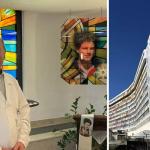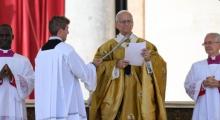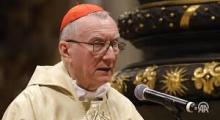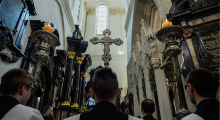Issued by the Catholic Center for Studies and Media - Jordan. Editor-in-chief Fr. Rif'at Bader - موقع أبونا abouna.org
Days after Carlo Acutis offered up his suffering from leukemia for Pope Benedict XVI and the good of the Catholic Church, the 15-year-old breathed his last in the pediatric oncology ward of San Gerardo Hospital of Monza, Italy, on Oct. 12, 2006 — a date that will soon be recognized as his feast day as the first millennial saint.
Physicians at San Gerardo Hospital remember the boy’s courage, love and empathy during his cancer treatment. The hospital chaplain who gave Acutis his last rites testified that he was “amazed by the composure and devotion” with which Carlo received Holy Communion before slipping into a coma due to a brain hemorrhage caused by his acute myeloid leukemia.
But Acutis was not the first saint to spend his final days in San Gerardo Hospital before going to God.
On Good Friday 1962, Gianna Molla, a 39-year-old Catholic doctor and mother, was admitted to give birth to her fourth child. It was same hospital where the young pediatrician had chosen to deliver her three previous children, but this time the hospital had also served as the location of a critical medical decision. Diagnosed with a uterine tumor early in pregnancy, Molla refused both an abortion and hysterectomy to preserve the life of her unborn child.
Like Acutis, Molla entered the hospital with a willingness to offer her life and her suffering for others. “If you have to decide between me and the baby, don’t hesitate … save her,” she told her husband Pietro.
Molla gave birth to a healthy daughter, Gianna Emanuela, by cesarean section on Holy Saturday. Soon after, Molla’s condition worsened due to the onset of septic peritonitis. During the next week in the hospital, she offered up short prayers, “Jesus, I love you” and “Jesus, help me.” She wanted to receive the Eucharist, but due to her frequent vomiting, she received just a small piece of the Eucharistic Host on her lips. She was taken to her home outside of Milan on the morning of April 28, where she died that day.
A hospital of miracles
Today, San Gerardo Hospital, a major public research and teaching hospital on the northeast outskirts of Milan, has a robust chaplaincy with two Catholic priests living full time in small dorm rooms inside the hospital so that they can be available 24/7 to serve the spiritual needs of the patients.
Father Riccardo Brena, one of the chaplains, calls it “a hospital of saints” — not only for its holy patients, but also for the miraculous healings tied to its halls.
One such miracle involved Pietro Schiliro, born in San Gerardo Hospital in 2002 with a severe lung malformation. His condition worsened, prompting his parents to have him urgently baptized in the Neonatal Intensive Care Unit. After one month in the hospital and a novena to the parents of St. Thérèse of Lisieux — Louis and Zélie Martin — the newborn’s health dramatically improved overnight. The Vatican recognized the case as a miracle in 2008, the first of two miracles leading to Sts. Louis and Zélie Martin becoming the first married couple to be canonized together.
In 2014, a pregnant mother treated at San Gerardo after her water broke at 13 weeks gave birth months later (in another hospital) to a healthy child on Christmas Day — a miracle attributed to Pope Paul VI, paving the way for his canonization.
Given these saintly intercessions, it may come as no surprise that this Italian hospital was also founded by a saint. The hospital celebrated the 850th anniversary of its founding last year by St. Gerardo dei Tintori, who used his inheritance to found the hospital for the aid of the poor and sick in 1174. So many miracles were attributed to St. Gerardo in the centuries after his death that St. Charles Borromeo investigated 20 of them when he served as archbishop of Milan.
Over the centuries, San Gerardo Hospital was moved and expanded several times, while maintaining the name of the saint. And it is still evolving; the 11th floor where Carlo Acutis was treated is currently undergoing a complete renovation.
A mission of hope
The parish church inside of the hospital contains a relic of its 12th-century patron, as well as relics of Carlo Acutis and Louis and Zélie Martin.
Father Brena often uses the relics in his ministry at the hospital as he prays with grieving families and offers the sacraments to the sick.
“I hope this can help so many people to believe and hope in the Lord, who is close to those who suffer,” he said.
Sporting a white lab coat over his clerical color, the chaplain said that he considers his work in the hospital as a “mission.” He baptizes babies who die within hours of being born, spends time with cancer patients, and accompanies the elderly as they near the end of life, bringing the gifts of the Eucharist, confession, holy oils for the anointing of the sick, and intercessory prayers for healing.
Much of his ministry consists of listening to people’s lives and their stories. He also ministers to hospital staff who need spiritual support while witnessing so much suffering, death and loss.
With more than 600 patients staying at the hospital at any given time, the priest acknowledges that he is not able to reach everyone. At the end of each day, he asks the Lord to be close to those whom he could not visit.
“In faith, I know that he comes where I am insufficient, because in our insufficiency God’s grace moves more than we do,” Father Brena said.
The chaplain encourages the people who enter the hospital chapel to pray, as Carlo Acutis did, in front of the tabernacle and to meet Jesus in the Eucharist.
The saints connected with the hospital also assist in his ministry. Father Brena shared the story of a couple whose young son, Pietro Carlo, was hospitalized with a serious leg infection. They prayed daily for Acutis’ intercession, keeping his image at the child’s bedside, and asked to receive Communion daily in imitation of Carlo. Doctors had expected a three-month stay. He recovered in two, “thanks to Carlo,” the chaplain added.
Father Brena, appointed as chaplain in 2022 after years as a parish priest, said this ministry has deepened his own faith. He recounted seeing hospital staff pool money together to buy clothing for a homeless patient so he could be discharged with dignity.
“The hospital treats everyone — rich, poor, all,” he said.
Dr. Claudio Cogliati, president of San Gerardo Hospital, told the Register that he plans to open a quiet space on the hospital campus called “The Garden of the Saints,” a tree-lined path with benches and signs with the stories of saints associated with the hospital.
The hospital is also preparing an exhibition on “the beauty of the crucifix,” showcasing 20 of the most famous depictions of the cross throughout history.
“No one wants to suffer,” Father Brena said. “But welcoming and accepting suffering means, for a Catholic, to unite it with the cross of Jesus. That cross becomes lighter and less heavy when offered to the cross of Jesus.”
The priest often reminds patients, “Death is not the end of everything, but the fulfillment of life.” Carlo Acutis, he said, teaches us that the value of life is not in years lived, but in how we live each day with grace.
The Italian city of Monza is best known for its Formula 1 racetrack, which passes so close to the hospital that the doctors say you can hear the race cars roar past on the day of the Grand Prix.
For the soon-to-be St. Carlo Acutis, who is known for calling the Eucharist “my highway to heaven,” San Gerardo Hospital was the final stop on the road to eternity. And the upcoming canonization of the 15-year-old boy who died of cancer carries a lasting message to the families whose loved ones are being treated at that hospital: that God can bring good out of even the worst tragedies.











